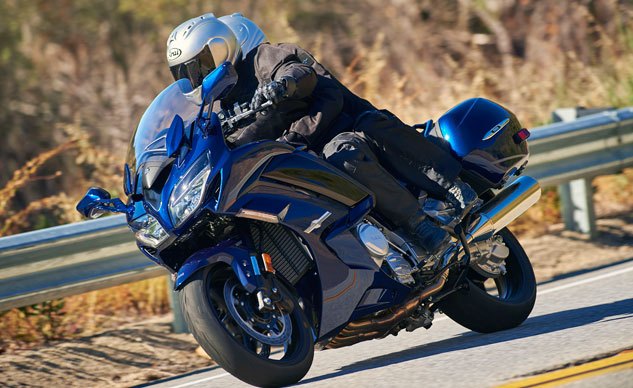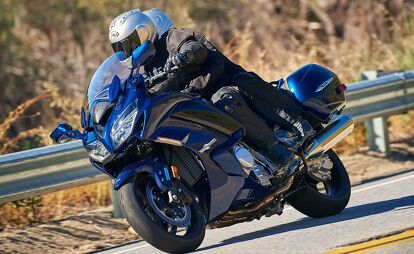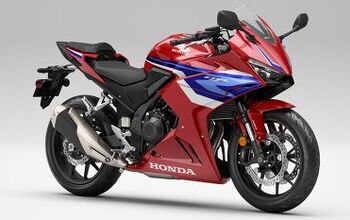2016 Yamaha FJR1300A and FJR1300ES First Look

Now with sixth gear and lean-sensitive headlights!
Yamaha is bringing the FJR1300A and FJR1300ES back for 2016, and while the bike might appear virtually identical to the previous model in these photos, there are some choice distinctions between old and new.
First and foremost, Yamaha has listened to the demands of its customers, and (finally) equipped both FJR models with a sixth cog in its transmission. Beyond simply adding a sixth gear, Yamaha revised individual ratios: first and second are slightly taller, while fourth and fifth gears are slightly shorter.
The changes don’t stop there though; both models receive an assist and slipper clutch Yamaha says reduces lever effort by about 20%. From there, both models see updated instrumentation and a completely redesigned “twin-eye” headlight and combination taillight/turn signal assemblies with LEDs.
It’s not surprising to see Yamaha utilize the Inertial Measurement Unit (IMU) first seen on its ground-breaking YZF-R1 on other models, however it’s a little bit of a shock to see the FJR1300ES (but not the FJR1300A) be the next beneficiary of the system. The touring bike is now equipped with lean-sensitive LED cornering lights. As the IMU detects lean angle, a series of three LED lights will activate in successive order to help further illuminate the road ahead.
All models make do with a conventional front fork and rear shock, while the ES is back for another year with its electronically adjustable suspenders at both ends. ES models are equipped with four preload settings, and a total of 10 damping adjustments to suit a rider traveling solo, two-up with bags loaded, and everything in between.
While not new features, the FJR1300A and FJR1300ES retain their traction control system, D-Mode selectable engine mapping, cruise control, electronically adjustable windscreen, ABS, UBS (Unified Braking System), heated grips, and 12V socket to charge accessories.
Of course, power for the FJR1300 comes from a liquid-cooled, DOHC, 1298cc inline-Four that churned out nearly 130 horses and 89 lb-ft of torque the last time we had one on the dyno, during our 2013 Sport-Touring Shootout 1.0.
You can have either the 2016 Yamaha FJR1300A or FJR1300ES in any color you want as long as it’s Cobalt Blue. Units are expected to arrive in dealerships beginning in March, with pricing set to be announced in February.

Troy's been riding motorcycles and writing about them since 2006, getting his start at Rider Magazine. From there, he moved to Sport Rider Magazine before finally landing at Motorcycle.com in 2011. A lifelong gearhead who didn't fully immerse himself in motorcycles until his teenage years, Troy's interests have always been in technology, performance, and going fast. Naturally, racing was the perfect avenue to combine all three. Troy has been racing nearly as long as he's been riding and has competed at the AMA national level. He's also won multiple club races throughout the country, culminating in a Utah Sport Bike Association championship in 2011. He has been invited as a guest instructor for the Yamaha Champions Riding School, and when he's not out riding, he's either wrenching on bikes or watching MotoGP.
More by Troy Siahaan
















































































































































Comments
Join the conversation
As of 2013 the bike's computer controlled the turn signals - why they haven't made them auto-cancelling is beyond me.
Unlike some others I am not displeased that they have left out a TPMS because I prefer the audible notification that the system on my Garmin Zumo gives me, along with graphs of pressure over time and such.
But I'm not changing my '14 ES for a new machine anytime soon anyway.
Going to a 6 gear transmission means more shifting and little else - the RPMs in top gear for the Gen-2 were not far off from what the competition does - the taller first gear implies a faster than 8mph idle speed too.
The slipper clutch, on the other hand might have utility, not that I have trouble with the traditional one on my ES nor with my previous A model (an 06). I DID find the changes made to the clutch slave on the Gen-3 made the engagement point somewhat vaguer than my previous bike - I have concerns that the slipper unit might make it vaguer still.
LED headlights are not for me - having saved my butt more times than I can recall, I REQUIRE a headlight modulator for my bikes and as far as I have seen no LED headlights properly support the technology . . . . and as far as I'm concerned the LED tail end SHOULD have been done co-incident with the release of the Gen-3. I have a set of Hella Micro DE HID driving lights on my bike so I throw a lot of light forward AND I get the benefit of the modulator.
It may not be clear to casual readers of the release, but perhaps it should be specifically noted that the 'A' model uses a traditional front fork with the slider tube on top and the ES uses upside down forks. There have been no suspension or other functional changes announced for 2016.
That's unfortunate, because I would have liked to see them implement a 'autoparked when off, return to last saved position' mechanism for the windscreen and I'd have liked to be able to control the heated grips directly, rather than having to choose three of the 10 possible settings and then cycle through those 3. I would also have liked to see the icon for instantaneous fuel consumption renamed . . . CRNT doesn't do it for me.
I hope that the Canadian version has a more accurate speedometer than what they've delivered to date - 12%-8% (it gets more accurate the faster you go, but never better than 8% optimistic) is too far off and to implement a speedometer healer requires that you install two of them, making it an relatively expensive fix.
So, in summary:
- a six speed transmission
- LED lighting front and rear
- Dynamic cornering lighting for the ES
- Slight retouches to the dash
And, in the US and presumably (because it isn't on their web site yet) in Canada as well, it is Blue,
But only "Cobalt Blue"? Yamaha, while building excellent bikes is absolutely tone deaf about many things.